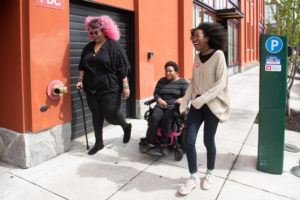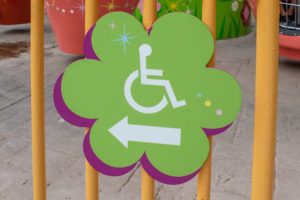The wheelchair access queue line, the closed-captioning on a ride safety video, the legendarily long paragraphs of signage telling you ‘if you have any of these conditions don’t go on this ride’ – inclusion of all guests – regardless of disability – in location-based experiences like theme parks, museums, amusement parks, immersive theater, and more often comes across as an afterthought. But it shouldn’t be: according to the World Health Organization there are over 1.3 billion people who have one or more disabilities1. They are a wellspring of humanity that our places, spaces, stories, and structures have historically excluded, ignored, or failed to serve. This community is far from a monolith, with varying wants, needs, and desires – just like any other group of potential employees, colleagues, collaborators, clients, or customers. And, like other historically marginalized groups, they have not only failed to see themselves meaningfully represented or welcomed into these places but also been subjected to laws, policies, and structural bias that have deprived them of agency and equal opportunity.

Historically, disability inclusion has focused on what’s necessary from a legal and safety standpoint. As with any global industry, location-based entertainment (LBE), and thus experience design, has to grapple with varying laws and regulations regarding inclusion of persons with disabilities. But it’s especially acute for experience design – the teams and clients we work with overseas are subject to different laws and regulations, and cultural sensibilities. The places we design and build must at the very least abide by local laws. It can feel overwhelming quickly.
But we can do so much better than the low bar of what’s legal. Philosophically we begin from two very simple suppositions.
- First, we must partner with subject matter experts, just as with other areas which contribute to the overall success of the project, center the voices of expertise and lived experience, and be transparent in our discussions.
- Second, laws and regulations define minimums for compliance, not optimal or practical scenarios of diverse accessibility. Abiding by, for instance, the Americans with Disabilities Act (ADA) means we can design an exhibit or ride that we won’t get sued for, but that doesn’t mean the resulting experience is welcoming, inclusive, or even good.
In a tight economy concerned with making up lost ground from the COVID-19 pandemic’s impact, it could be all too easy to do the minimum – that doesn’t just lead to an inferior product, it is also short-sighted, creates a poor user experience not only for the individual but also for the accompanying friends and family, and leaves significant money on the table.
This is not a tiny demographic with a small financial impact: in 2018-19, more than 27 million travelers with disabilities took a total of 81 million trips, spending $58.7 billion on their own travel alone (up from $34.6 billion in 2015). Open Doors Organization (ODO) – a non-profit that strives to educate businesses on disability inclusion in the workplace – noted with speaker and ODO Executive Director Eric Lipp, that “the true economic impact is higher, potentially even double, since people with disabilities typically travel with one or more other adults.”2 In an effort to engage the disability community, it is not enough to simply have good intentions. “Nothing about us without us,” a mantra in disability activism that gained traction in the 1990s, isn’t just a snappy slogan: it is foundational to being successful.
Even in the course of writing this article, Thinkwell and our friends at Ruh Global IMPACT – a leading consultant agency who amplify the impact of organizations’ disability inclusion strategies – had a spirited discussion about person-first (“people with disabilities”) and identity-first (“disabled people”) language. It speaks to the importance of having a variety of empowered voices at the table from the very beginning – and in this case, of simply asking what language someone prefers, honoring that input, and realizing different people will have varying perspectives.3 Recently there’s been a movement in disability activism to use identity-first language, and Thinkwell tends to utilize a mix of identity-first and person-first as a result, depending on the context, situation, and the stated preference of those involved. Ruh Global’s inclusive team preferentially uses person-first. You’ll see in future articles, if we are quoting from or interviewing an individual, we will use their preferred terminology and we’ll be explicit about it – so there’s every possibility you’ll see multiple terminology choices in a single article, depending upon the people involved. Everyone has different wants and needs, and this isn’t one-size-fits-all.

Similarly, in our design processes, we cannot treat persons with disabilities as tokens or use a one-size-fits-all approach. A guest who is blind may have some accessibility needs and concerns that overlap with a wheelchair-user, but simply put, they fundamentally do not have all the same needs. Meeting the needs of one segment but shrugging and saying meeting the needs of other segments is too hard, expensive, or impinges on the work environment or designed experience is unacceptable. In order to fully live up to “nothing about us without us”, companies must be willing to put in the work to examine their culture and policies for ways in which they are unwelcoming, exclusionary, and/or biased; redress those failings; re-evaluate and iterate. They must genuinely listen when team members with lived experiences or focus group participants from the persons with disabilities community give them negative feedback and incorporate that input into the work. It’s not all negative – this is an opportunity for designers and teams to get creative and innovative.
Universal design, which in our context means to craft environments and experiences that can be used by the greatest number of people, is our holy grail. Wheelchair access queues on rides are useful, but oftentimes they mean guests who utilize them miss out on the pre-show experience. Offering sign language interpretation of shows is helpful, but when it needs to be booked two weeks in advance it’s inconvenient and exclusionary. Universal design is better for everyone, whether it’s seating and rest opportunities in a queue making it easier and more comfortable for a kid who’s flagging by 3 pm or someone with a balance disorder to wait in line for a ride, or provide clear and easy means to increase font size on a touch screen for guests with low vision or emergent readers or the aging. Just like moms with strollers, tourists with rolling luggage, and food cart vendors use the curb cuts originally designed for people who use wheelchairs, universal design in location-based entertainment makes a better experience for everyone.
Photo Credit: Disabled And Here